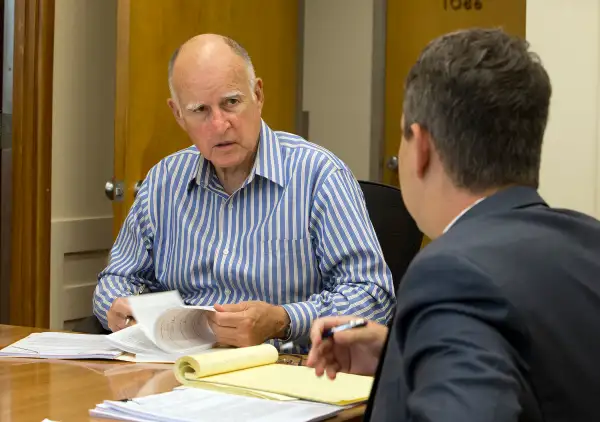How California Is Pioneering a New Retirement Savings Plan

California is about to give millions of workers a big boost toward retirement security. Late Wednesday, the California Senate approved legislation to set up a state retirement savings program called Secure Choice that would provide coverage to nearly 7 million small-business employees in the state who lack access to workplace plans. The bill is expected to be signed by Gov. Jerry Brown within the next few weeks.
The Secure Choice plan would require small employers to auto-enroll workers in an IRA. That puts California on track to become the largest state to set up a state savings program—but it's far from the first. Washington has approved a program that is scheduled to launch Jan. 1, 2017, and six other states, including Oregon, Illinois and Connecticut, have enacted legislation to set up plans of their own. All told, at least 30 states are in various stages of setting up retirement plans—some mandatory for employers and some voluntary—according to the Georgetown University Center for Retirement Initiatives.
With the launch of California Secure Choice, the movement is approaching critical mass. "California is a game-changer," says Georgetown Center executive director Angela Antonelli, who expects the program will bring national attention to the retirement coverage gap.
Studies show that more than half of workers—some 55 million nationwide—lack workplace retirement plans, especially those employed by small businesses and freelancers. And when it comes to putting money away, an employer nudge really matters: 90% of those with workplace plans save for retirement vs. only 20% of those without one.
An obvious solution would be to establish a national auto-IRA plan that would allow these workers to save without an employer-sponsored program. But despite repeated bipartisan efforts, auto-IRA legislation hasn't been approved by Congress. So individual states have decided to step in—a movement that recently received support from the U.S Department of Labor, which issued rules offering a clearer roadmap for states to set up their own retirement plans, says Sarah Mysiewicz Gill, senior legislative representative at AARP.
The state initiatives differ in their approaches. Some are setting up plan-provider marketplaces that employers can sign up for on a voluntary basis, but most are mandating that employers auto-enroll workers in a state-provided savings program, which is the case in California. Workers can always opt out, as they can in 401(k) plans.
Though the initial target for the California plan was a 2017 launch, the program is more likely to get going in 2018, says state Treasury Secretary John Chiang, who also heads the California Secure Choice Retirement Savings Investment Board.
Given the size of the worker population, the schedule calls for a gradual rollout, starting with the smallest employers. "Projections show that the plan is likely to get 1.6 million workers enrolled in the first year," says Blanca Castro, Sacramento Metro Manager forAARP, who has been tracking the legislation.
The program's details are still being hammered out. As currently outlined, private-sector businesses with five or more workers that don't currently offer a retirement plan must auto-enroll employees in an IRA. (It's still not clear whether that IRA will be a Roth or traditional account.) The default contribution level may be 3%, which may be increased automatically. Administrative fees would be capped at 1%.
For the first three years, worker contributions would be stashed in a safe investment, such as Treasuries, while the program administrators select an investment manager, who would eventually offer a broader range of options. The model being used is the myRA, the ultrasafe retirement savings option introduced by President Obama in 2014 for investors just starting out. (You can sign up for your own myRA account at the U.S. Treasury website.)
The California Secure Choice program has garnered broad support, as tweaks to the plan led industry groups, such as the California Chamber of Commerce, to drop opposition. But there are still critics. The Investment Company Institute, the trade organization for the fund industry, has argued that the program may be too expensive to manage, since it will probably attract smaller accounts that lack economies of scale.
Still, many asset-management companies, including robo-adviser firms like Betterment and Wealthfront, manage small accounts for low fees. And the feasibility study for the program projects that even at high opt-out rates, there would be sufficient assets to maintain cost-effectiveness. "Our goal is to drive down costs as low as possible," says Chiang.
That said, the state savings initiative does raise a key question: Is this really the best way to close the retirement savings gap? A patchwork quilt of 50 state plans, however efficiently run, will still lack the economies of scale of giant programs like the federal Thrift Savings Plan or public pension plans. As the Boston College Center for Retirement Research recently noted,
Even if more states are successful in setting up a tier of retirement income for their citizens, this approach to implementing a retirement program is clearly a second-best alternative. A national Auto-IRA plan would be a much more efficient way to close the coverage gap, offering substantial economies of scale and avoiding the laborious, time-consuming, and expensive process of setting up 50 different state plans.
It's possible that the state savings initiatives may spur more interest in finally establishing a national auto-IRA or perhaps even a national mandatory savings plan. But those efforts will undoubtedly have to wait until the next president gets around to focusing on the retirement savings crisis.
